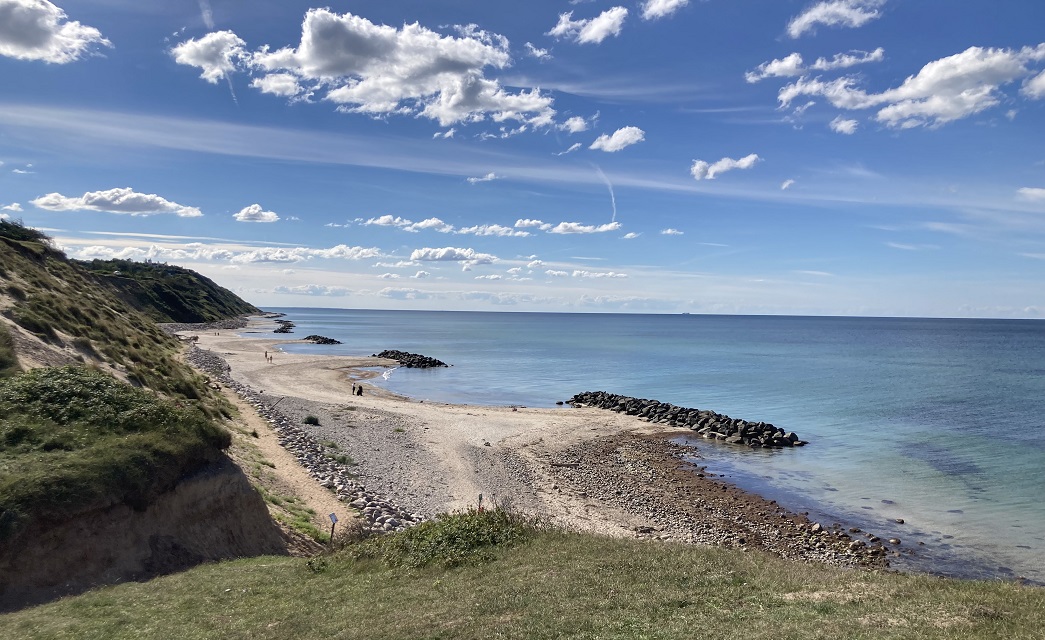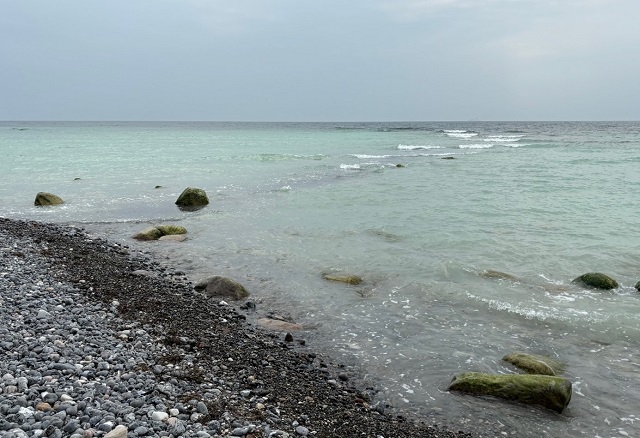Forskningsinteresser

The coast at Klitgaarden Landowners Association taken from Heather Hill (foto OJJ).
The project for breakwaters, slope protection and sand feeding at COWI

The coast off Brøndehøje with light wave breaking over an underwater “pier construction”, which may be a natural geological formation or probably improved by human intervention 500 years ago (photo OJJ, March 2024)
My work with hydraulic engineering, coastal engineering and breakwaters has taken me far and wide and has given rise to the publication of many articles etc. on the subject, including the important ICE papers in 2013 and 2024 on “safety of breakwaters with monolayer armour units” presented at conferences in Scotland and England, see links for download below.
Furthermore, I published a paper for the ICSE conference on scour and erosion in Copenhagen in 2024, where I “nostalgia” revisited what had happened to the large river training structures that I worked with studies and design, the FAP 1 project Halcrows/DHI on a little more than 30 years ago during 2.5 years in Bangladesh for DHI.
However, the last few years, and in parallel with the fact that I have worked more and more in Denmark both at COWI, among other projects with the Lynytteholm project in Copenhagen, but also with coastal protection projects in my own company “Ole Juul Kystteknik”, my interest in historical storm surges in the Inner Danish Waters has grown. This is also a consequence of the fact that the Danish authorities, Kystdirektoratet (Coastal Directorate ), do not take the historical data into account in their published high water statistics, latest in the 2024 edition.
The result is that these statistics, as stated by MS/KDI, are to be used partly to assess whether a given storm, at a given location, has been a 20-year event. If this is the case, it gives rise to the storm council declaring a “storm surge”, and compensation can be given. These statistics can be used for this. However, it is also written that they can be used to assess design data for marine and coastal projects; which in many cases will give rise to a very serious underestimation of the most extreme water levels. This can lead to misinvestment and major damage when large storm surges invariably occur again. Therefore, in my opinion, this is currently a matter of misleading the public.
While searching for data and information regarding extreme storm surges from the east, I came across the storm surge of 1 Feb. 1625, which destroyed the town of Brøndehøje on the southeastern coast of the Island, Møn. According to available data from Northern Germany, this is almost as powerful as the well-known storm surge of 1872. The town was an important place for herring fishing and for exporting herring in barrels to the Hanseatic cities, especially Lübeck. I have therefore been interested in this special place for the past year, and have become aware of whether there should have been a harbour on this very exposed coast, either natural geological formations of rocks on the sea bed or possibly a natural formation improved by rock dumping for better wave disturbance conditions. The COWI Foundation has supported the investigation of the site by diving inspection by providing funds for the Møns Sportsdykkerklub (diver club), diver inspection and multibeam soundings/survey of the seabed carried out by SensorSurvey A/S.
This will be published later in 2025
Vigtige eksterne dokumenter vedr. stormfloder:
Realdanica: Byernes udfordringer med havvandsstigning og stormflod, COWI, 2017
Gram-Jensen, I., (1991). Stormfloder. Danish Meteorological Institute Scientific Report 91-1. Copenhagen. DMI.
COWI (1997). Ørestadsselskabet I/S, Minimetro Phase 1, Civil Works of the Minimetro II.
Opdateret overslag for sikring af København mod oversvømmelse. Rapport, april 2017. Københavns Kommune. COWI (2018).
Vandstandsstatistik for Køge Havn. Udarbejdet af Dansk Hydraulisk Institut for Køge Kommune, december 2006.
Colding, A. (1881). Stormen over Nord- og Mellem-Europa af 12te-14te November 1872 og over den derved fremkaldte Vandflod i Østersøen. Vidensk.Selsk.Skr, 6. rk., Naturvidenskabelig og Matematisk Afd. I. 4.
Stormfloden 1872, da Østersøen druknede Danmark, Peter Aakjær & Erik Buch, Forlaget Epsilon, 2022
Die Küste, 92 – 1872 – An exceptional storm surge in the Baltic KFKI_DieKueste_92_2022_A.pdf’
Let us collaborate on climate adaptation and coastal engineering projects
The home page has been initiated in order to better get into contact with others that are facing these problems, or that have a special interest in these subjects. Thereby, we may have fruitful dialog for enhancing the knowledge that is so very important for the future climate adaptation of towns and coastal areas in Denmark and abroad.
Contact me to see whether there is a basis for cooperation about solving coastal engineering problems, or for a dialog about this very interesting subject, that I, always and still, personally take much interest in.
- + 45 40181402
- olejuuljensen2022@gmail.com